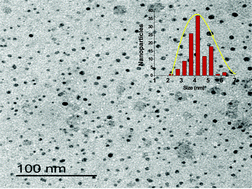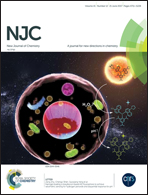Thermo-responsive microgels based on encapsulated carbon quantum dots†
Abstract
In this work carbon quantum dot (CQD) nanoparticles are synthesized from D-lactose using a hydrothermal method and then they are coated with polyethylene glycol (CQDs@PEG). These particles exhibit a monodisperse spherical morphology with an average particle size of ∼4 nm. Nuclear magnetic resonance (NMR) and Fourier transform infrared (FTIR) spectroscopy showed the presence of the hydroxyl groups from the ethylene glycol molecules grafted onto the CQDs’ surfaces, which confirms that PEG was covalently attached to the nanoparticles’ surfaces. Fluorescence analysis demonstrates a shift in the emission at 495 nm after PEG coating. Modified carbon dots were introduced into thermo-responsive pNIPAM microgels. The resultant pNIPAM–CQDs@PEG hybrid system exhibits interesting fluorescence properties. Transmission electron microscopy (TEM), fluorescence microscopy, and energy-dispersive X-ray (EDX) spectroscopy confirm the incorporation of CQD particles into the microgels. Finally, dynamic light scattering (DLS) analysis confirms that further hybrid microgels based on pNIPAM are thermo-responsive, with a transition temperature similar to that of a system with an ionic component.



 Please wait while we load your content...
Please wait while we load your content...